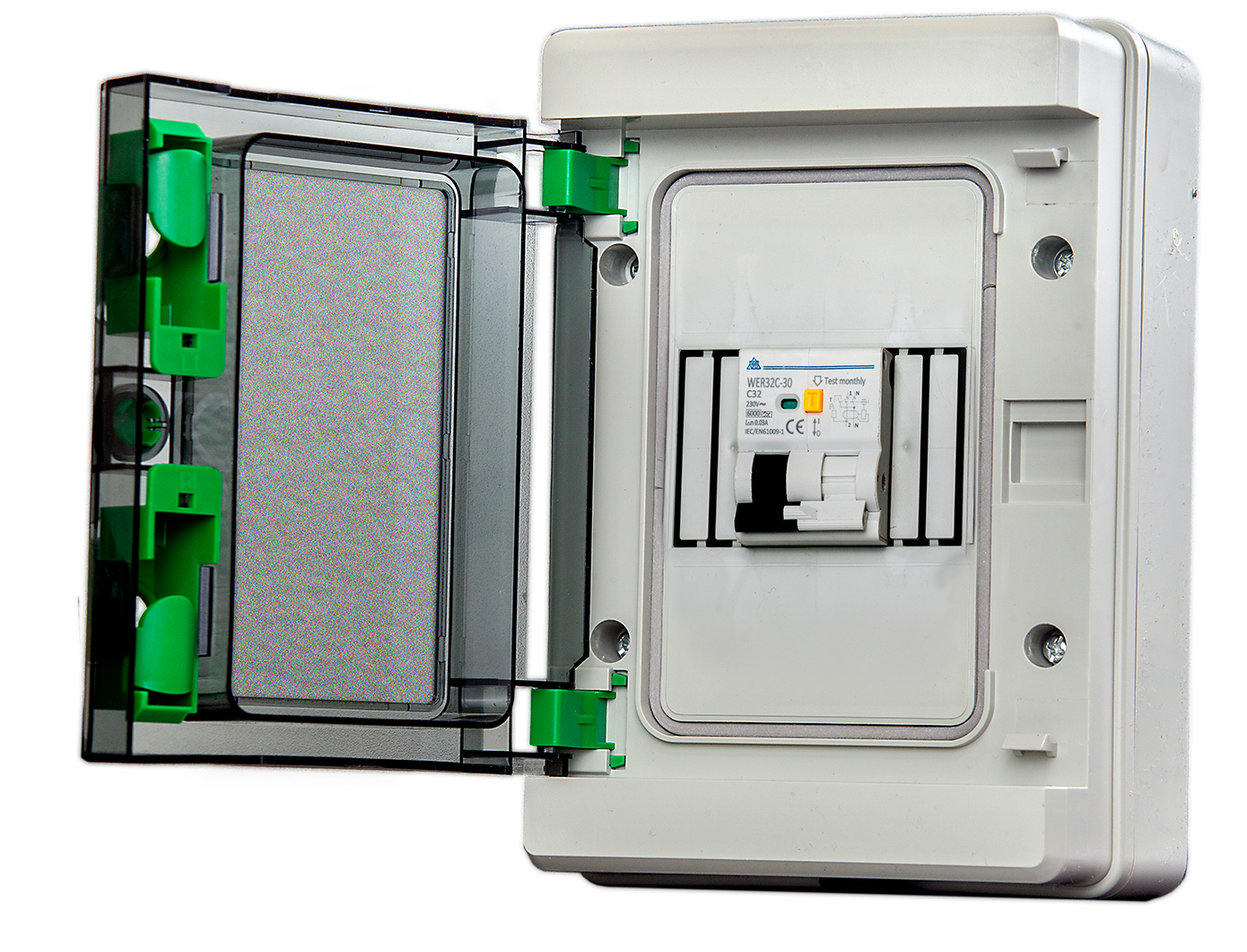
When you’re fitting an EV charger, the consumer unit is the first thing an assessor will look at. Get it wrong and the whole install risks failing inspection. Get it right and you’ve got a safe, compliant, future-proof setup that protects both the charger and the customer.
This checklist covers the essentials every installer should confirm before ordering an EV charger consumer unit.
🔎 Jump To:
- Confirm the Supply Capacity
- Choose the Right RCD/RCBO
- Surge Protection is Mandatory
- PEN / PME Fault Protection
- Mounting Height & Accessibility
- Protect the Enclosure Rating
- Outdoor Units – Don’t Cut Corners
- Products That Deliver
- FAQs
- Final Word
1. Confirm the Supply Capacity
Before you even think about ordering the board, check what’s feeding it. An undersized fuse or looped supply is a guaranteed fail – and could put the whole install at risk.
- Check the service head and main fuse rating.
- A 7kW charger on a 60A main fuse is pushing limits – most DNOs want to see 80A or 100A.
- Watch out for looped supplies (shared cables with a neighbour) – these usually need splitting before EV install.
Failing to check supply capacity is one of the fastest ways to fail inspection.
🔌 Related product: 100A Meter Isolator for safe supply upgrades.
2. Choose the Right RCD/RCBO
Get this wrong and you’ll be back on site replacing devices. The regs are crystal clear: Type AC is out, and Type A or B (depending on charger type) is the way forward.
- Type AC is not acceptable under the 18th Edition A2.
- Type A RCBO is the minimum, isolating both line and neutral.
- Some chargers require Type B if they produce smooth DC leakage.
💡 See also: What Is an EV Consumer Unit - And Why Do You Need One for Charger Installs?
Pro tip: Go for a pre-wired EV board with Type A RCBO + SPD already fitted. It saves install time and avoids device mismatches.
🔌 Shop RCBOs: Mini Type A RCBO 6–40A | 4 Pole A Type RCBO
3. Surge Protection is Mandatory
There’s no wiggle room here. Amendment 2 makes SPDs compulsory, and with EV chargers full of sensitive electronics, leaving one out is asking for trouble.
- Amendment 2 makes SPDs compulsory on all new circuits unless a risk assessment rules them out.
- For EV installs, the safe assumption is: always fit an SPD.
- Type 2 SPD covers most domestic chargers. On TT systems, use Type 1+2.
- Keep cable runs short (<10m) for compliance.
⚡ See also: What Surge Protection Does an EV Charger Install Need?
🔌 Popular SPDs: Single Module SPD (Type 2) | Metal Surge Arrestor Unit
4. PEN / PME Fault Protection
If the property has a PME earthing system, you need to protect against open PEN faults. Traditionally this meant driving an earth rod – but modern PME consumer units come with integrated PEN fault detection.
Result: safer installs, faster fit, no digging rods into driveways.
🔎 See also: Do You Still Need an Earth Rod with PME Fault Protection?
🔌 PME-ready boards: PME Load Balancing Unit
5. Mounting Height & Accessibility
The IET Code of Practice + Equality Act guidance recommends:
- Min: 0.5m above ground
- Max: 1.5m
- Best practice: 0.75m–1.2m for accessibility
This avoids bumper strikes, flood risk, and ensures usability for all clients.
6. Protect the Enclosure Rating
Audits show around a third of EV installs compromise the enclosure IP rating. Common mistakes:
- Drilling holes without glands or grommets
- Leaving screw holes unsealed
- Not seating gaskets properly
Always use manufacturer-supplied glands, seals, and washers. A board rated IP65 in the box won’t stay that way if you bodge the penetrations.
🔌 Accessory: IP68 Tails Gland for compliant entries.
7. Outdoor Units – Don’t Cut Corners
Cheap plastic boards stuck outside meter boxes might look like a quick fix – but they rarely comply. Issues include:
- RCDs not tested for low-temp outdoor operation
- Condensation and pollution not accounted for
- Missing SPD or PME protection
Instead, spec a proper metal EV consumer unit or an IP-rated PME board.
🔌 Options: IP65 EV Surge Unit | IP65 PEN Fault Detection Unit
8. Products That Deliver
At Power & Data UK, we stock EV boards designed to pass inspection first time:
- 4 Way EV Protection Unit – Type A RCBO + SPD
- EV Surge Unit – 100A Isolator + SPD + MCB
- 3 Phase EV Boards with SPD
📘 See also: How to Install an EV Consumer Unit - What Every Installer Should Know
FAQs About EV Charger Consumer Units
Installers ask the same questions time and time again when it comes to EV boards. We’ve cut through the noise with clear, straight answers to the ones that matter most.
Final Word
Before you order an EV charger consumer unit, run through this checklist:
- Check the supply
- Choose the right RCBO/RCD
- Always fit surge protection
- Add PME fault detection if required
- Mount and seal correctly
Get those right, and your EV installs will sail through inspection, protect your client’s investment, and save you from call-backs.
👉 Next step: Browse our full range of EV Consumer Units & Kits to spec the right solution first time.
